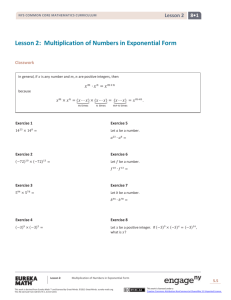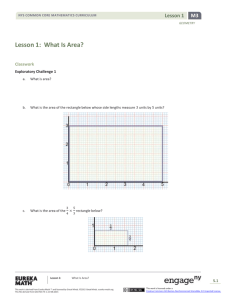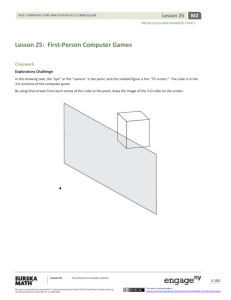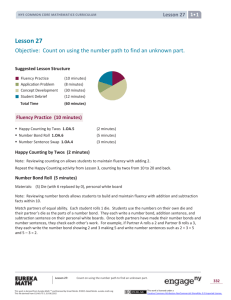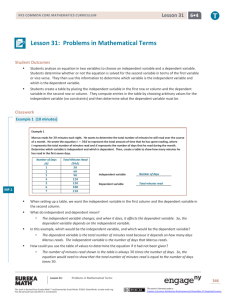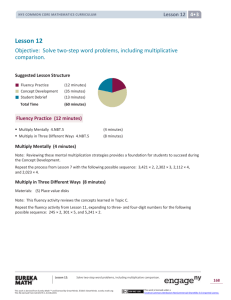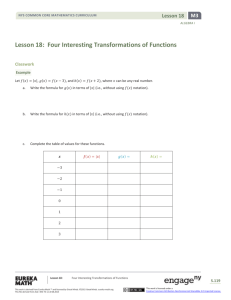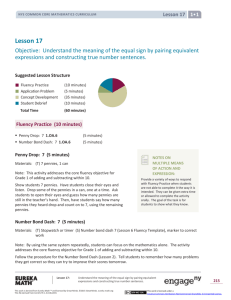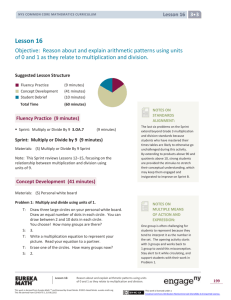Prekindergarten Mathematics, Module 1, Topic C
advertisement
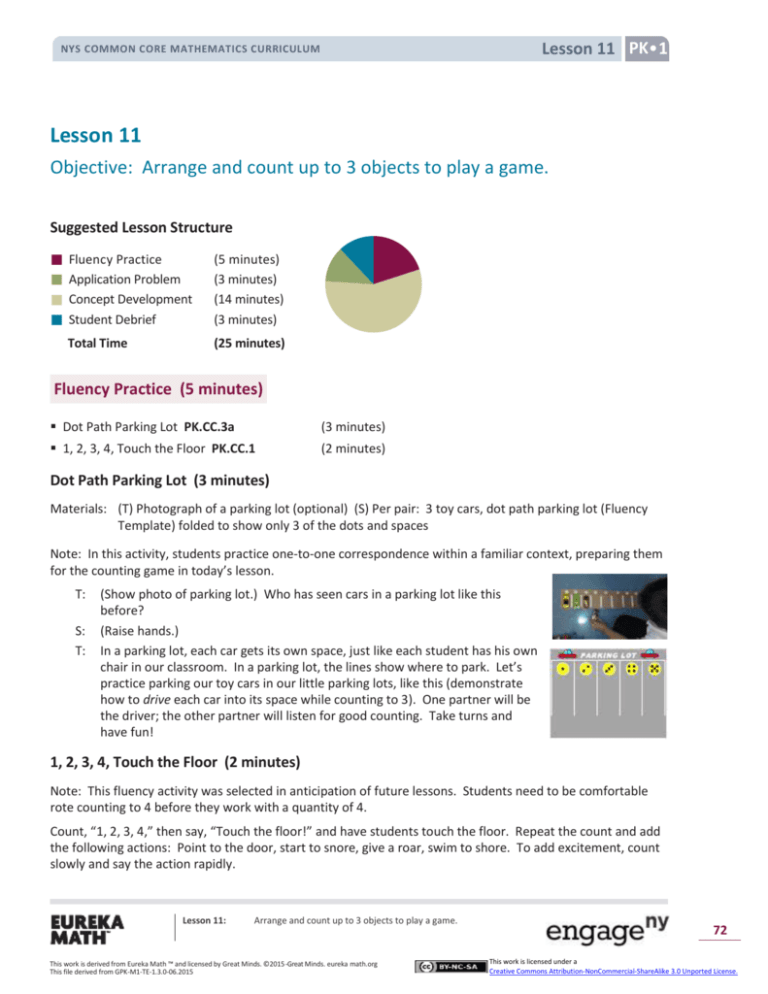
Lesson 11 PK NYS COMMON CORE MATHEMATICS CURRICULUM Lesson 11 Objective: Arrange and count up to 3 objects to play a game. Suggested Lesson Structure Fluency Practice Application Problem Concept Development Student Debrief Total Time (5 minutes) (3 minutes) (14 minutes) (3 minutes) (25 minutes) Fluency Practice (5 minutes) Dot Path Parking Lot PK.CC.3a (3 minutes) 1, 2, 3, 4, Touch the Floor PK.CC.1 (2 minutes) Dot Path Parking Lot (3 minutes) Materials: (T) Photograph of a parking lot (optional) (S) Per pair: 3 toy cars, dot path parking lot (Fluency Template) folded to show only 3 of the dots and spaces Note: In this activity, students practice one-to-one correspondence within a familiar context, preparing them for the counting game in today’s lesson. T: S: T: (Show photo of parking lot.) Who has seen cars in a parking lot like this before? (Raise hands.) In a parking lot, each car gets its own space, just like each student has his own chair in our classroom. In a parking lot, the lines show where to park. Let’s practice parking our toy cars in our little parking lots, like this (demonstrate how to drive each car into its space while counting to 3). One partner will be the driver; the other partner will listen for good counting. Take turns and have fun! 1, 2, 3, 4, Touch the Floor (2 minutes) Note: This fluency activity was selected in anticipation of future lessons. Students need to be comfortable rote counting to 4 before they work with a quantity of 4. Count, “1, 2, 3, 4,” then say, “Touch the floor!” and have students touch the floor. Repeat the count and add the following actions: Point to the door, start to snore, give a roar, swim to shore. To add excitement, count slowly and say the action rapidly. Lesson 11: Arrange and count up to 3 objects to play a game. This work is derived from Eureka Math ™ and licensed by Great Minds. ©2015 -Great Minds. eureka math.org This file derived from GPK-M1-TE-1.3.0-06.2015 72 This work is licensed under a Creative Commons Attribution-NonCommercial-ShareAlike 3.0 Unported License. Lesson 11 PK NYS COMMON CORE MATHEMATICS CURRICULUM Application Problem (3 minutes) Materials: (S) Blank 5-group strip (Template 1) or 1" wide strip of blank paper, crayon Have students search around the room for items that are grouped together in a linear configuration (e.g., paint bottles, books, chairs at table). Then, give each student an empty 5-group strip and have him choose a line (of 2 or 3 objects), drawing that number of dots on his strip (from left to right) with a crayon and sharing it with a partner. Note: As children identify and count objects arranged in linear configurations in their classroom environment, they begin to connect the math concepts they are learning to the real world. If children are not ready to draw dots, use stickers to create a dot strip. Concept Development (14 minutes) Part 1: Concept Introduction Materials: (T) Bear game board (Template 2), 2 teddy bear counters (e.g., 1 red, 1 blue), stack of 9 dot cards with 3 threes, 3 twos, 3 ones (Lesson 10 Template 3) 1. Show teddy bear counters and tell students, “Let’s play a game! These bears are going to march to get to the beehive!” 2. Choose two students, Partner A and Partner B, to model the game. Give Partner A the red bear and Partner B the blue bear. Both bears should be placed at the start sign. 3. Partner A picks a card from the stack. Partner B asks, “How many dots are there?” 4. Partner A touches and counts the number of dots on the card and moves the red bear that many footprints along the trail. Partner B asks, “How many spaces did your bear march?” 5. The class counts the number of spaces the red bear traveled on the trail. 6. Guide Partner B to repeat Steps 3–5. Focus on cardinality by ensuring the bear stops on the last number counted, “The bear stops moving when he gets to [number of dots on card]!” 7. Continue to alternate between Partners A and B. Lesson 11: Arrange and count up to 3 objects to play a game. This work is derived from Eureka Math ™ and licensed by Great Minds. ©2015 -Great Minds. eureka math.org This file derived from GPK-M1-TE-1.3.0-06.2015 73 This work is licensed under a Creative Commons Attribution-NonCommercial-ShareAlike 3.0 Unported License. NYS COMMON CORE MATHEMATICS CURRICULUM Lesson 11 PK Part 2: Practice Materials: (S) Per pair: bear game board (Template 2), 2 teddy bear counters (e.g., 1 red, 1 blue), stack of 9 dot cards with 3 threes, 3 twos, 3 ones (Lesson 10 Template 3) 1. 2. MP.6 3. 4. Pair students and send them to the prepared tables. Tell students to take turns picking a card, counting, and placing their bear counters on the game board. Remind them to start at the sign. Encourage partners to ask each other, “How many dots are there?” and “How many spaces did your bear march?” Circulate and use parallel talk, emphasizing when students stop on the correct space: “Marshall counted 2 dots, so he moved his bear 2 spaces and stopped.” Student Debrief (3 minutes) Lesson Objective: Arrange and count up to 3 objects to play a game. The Student Debrief is intended to invite reflection and active processing of the total lesson experience. It is also an opportunity for informal assessment. Consider taking anecdotal notes or using a simple checklist to note each child’s progress toward meeting the lesson objective. As students complete the Practice portion of the Concept Development, listen for misconceptions or misunderstandings that can be addressed in the Debrief. Any combination of the questions below may be used to help students express ideas, make connections, and use new vocabulary. What number would help the bears get to the beehive the fastest? Slowest? What important question did you ask your partner when it was her turn to pick a card? Did your game board remind you of the dots you drew earlier? How? Lesson 11: Arrange and count up to 3 objects to play a game. This work is derived from Eureka Math ™ and licensed by Great Minds. ©2015 -Great Minds. eureka math.org This file derived from GPK-M1-TE-1.3.0-06.2015 NOTES ON MULTIPLE MEANS FOR ACTION AND EXPRESSION: Some students benefit from a partner share before answering questions in a larger group. This provides students who may struggle with language an opportunity to practice and feel comfortable before sharing with the class. CENTER CONNECTION: Give children an opportunity to continue playing the game during centers. They can cut up the game board and make their own path from the sign to the beehive. Children who are ready can also make their own dot cards for the game. 74 This work is licensed under a Creative Commons Attribution-NonCommercial-ShareAlike 3.0 Unported License. NYS COMMON CORE MATHEMATICS CURRICULUM Lesson 11 Fluency Template PK PARKING LOT dot path parking lot Lesson 11: Arrange and count up to 3 objects to play a game. This work is derived from Eureka Math ™ and licensed by Great Minds. ©2015 -Great Minds. eureka math.org This file derived from GPK-M1-TE-1.3.0-06.2015 75 This work is licensed under a Creative Commons Attribution-NonCommercial-ShareAlike 3.0 Unported License. NYS COMMON CORE MATHEMATICS CURRICULUM Lesson 11 Template 1 PK blank 5-group strips Lesson 11: Arrange and count up to 3 objects to play a game. This work is derived from Eureka Math ™ and licensed by Great Minds. ©2015 -Great Minds. eureka math.org This file derived from GPK-M1-TE-1.3.0-06.2015 76 This work is licensed under a Creative Commons Attribution-NonCommercial-ShareAlike 3.0 Unported License. NYS COMMON CORE MATHEMATICS CURRICULUM Lesson 11 Template 2 PK bear game board Lesson 11: Arrange and count up to 3 objects to play a game. This work is derived from Eureka Math ™ and licensed by Great Minds. ©2015 -Great Minds. eureka math.org This file derived from GPK-M1-TE-1.3.0-06.2015 77 This work is licensed under a Creative Commons Attribution-NonCommercial-ShareAlike 3.0 Unported License.

